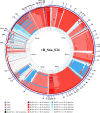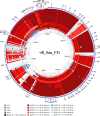Broad-range lytic bacteriophages that kill Staphylococcus aureus local field strains
- PMID: 28742812
- PMCID: PMC5526547
- DOI: 10.1371/journal.pone.0181671
Broad-range lytic bacteriophages that kill Staphylococcus aureus local field strains
Erratum in
-
Correction: Broad-range lytic bacteriophages that kill Staphylococcus aureus local field strains.PLoS One. 2017 Oct 27;12(10):e0187387. doi: 10.1371/journal.pone.0187387. eCollection 2017. PLoS One. 2017. PMID: 29077755 Free PMC article.
Abstract
Staphylococcus aureus is a very successful opportunistic pathogen capable of causing a variety of diseases ranging from mild skin infections to life-threatening sepsis, meningitis and pneumonia. Its ability to display numerous virulence mechanisms matches its skill to display resistance to several antibiotics, including β-lactams, underscoring the fact that new anti-S. aureus drugs are urgently required. In this scenario, the utilization of lytic bacteriophages that kill bacteria in a genus -or even species- specific way, has become an attractive field of study. In this report, we describe the isolation, characterization and sequencing of phages capable of killing S. aureus including methicillin resistant (MRSA) and multi-drug resistant S. aureus local strains from environmental, animal and human origin. Genome sequencing and bio-informatics analysis showed the absence of genes encoding virulence factors, toxins or antibiotic resistance determinants. Of note, there was a high similarity between our set of phages to others described in the literature such as phage K. Considering that reported phages were obtained in different continents, it seems plausible that there is a commonality of genetic features that are needed for optimum, broad host range anti-staphylococcal activity of these related phages. Importantly, the high activity and broad host range of one of our phages underscores its promising value to control the presence of S. aureus in fomites, industry and hospital environments and eventually on animal and human skin. The development of a cocktail of the reported lytic phages active against S. aureus-currently under way- is thus, a sensible strategy against this pathogen.
Conflict of interest statement
Figures








References
-
- Chang HH, Cohen T, Grad YH, Hanage WP, O'Brien TF, Lipsitch M (2015) Origin and proliferation of multiple-drug resistance in bacterial pathogens. Microbiol Mol Biol Rev 79: 101–116. doi: 10.1128/MMBR.00039-14 - DOI - PMC - PubMed
-
- Payne DJ, Miller LF, Findlay D, Anderson J, Marks L (2015) Time for a change: addressing R&D and commercialization challenges for antibacterials. Philos Trans R Soc Lond B Biol Sci 370: 20140086 doi: 10.1098/rstb.2014.0086 - DOI - PMC - PubMed
-
- Zorzet A (2014) Overcoming scientific and structural bottlenecks in antibacterial discovery and development. Ups J Med Sci 119: 170–175. doi: 10.3109/03009734.2014.897277 - DOI - PMC - PubMed
-
- Bassetti M, Carnelutti A, Righi E (2017) The role of methicillin-resistant Staphylococcus aureus in skin and soft tissue infections. Curr Opin Infect Dis. - PubMed
-
- Knox J, Uhlemann AC, Lowy FD (2015) Staphylococcus aureus infections: transmission within households and the community. Trends Microbiol 23: 437–444. doi: 10.1016/j.tim.2015.03.007 - DOI - PMC - PubMed
MeSH terms
LinkOut - more resources
Full Text Sources
Other Literature Sources

